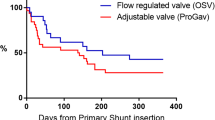Abstract
Due to an increasing number of shunt complications with conventional valves, we performed a study of 80 flow-regulated Orbis-Sigma valves implanted in 47 children who had had repeated complications with conventional valves and 33 children receiving their first shunt. The results were encouraging. During the first 5 years after implantation, the probability of absence of any kind of surgical intervention to the valve system was 57% and the probability satisfactory function of the valve itself was 70%. The most frequent complication was underdrainage of CSF, especially in children under the age of 1 year. No cases of CSF overdrainage occurred in this series. The Orbis-Sigma valve appears especially useful for patients unable to tolerate the anti-siphon device, and for patients over 1 year old receiving their first valve for hydrocephalus of non-tumoral and non-haemorrhagic origin.
Similar content being viewed by others
References
Anon (1985) The Sophy programmable pressure valve: instructions for use (Product bulletin). Sophy s a, France
Coker S (1987) Cyclic vomiting and the slit ventricle syndrome. Pediatr Neurol 3:297–299
Faulhauer K, Schmitz P (1978) Overdrainage phenomena in shunt treated hydrocephalus. Acta Neurochir (Wien) 45:89–101
Griedel R, Khan M, Tan L (1985) CSF shunt complications: an analysis of contributory factors. Child's Nerv Syst 1:77–80
Gruber R (1980) The problem of chronic overdrainage of the ventriculoperitoneal shunt in congenital hydrocephalus. Z Kinderchir 31:362–363
Gruber R (1981) The relationship of ventricular shunt complications to the chronic overdrainage syndrome. A follow-up study. Z Kinderchir 34: 346–352
Gruber R, Jenny P, Herzog B (1984) Experiences with the anti-siphon device (ASD) in shunt therapy of paediatric hydrocephalus. J Neurosurg 61:156–162
Hoppe-Hirsch E, Sainte-Rose C, Renier P, Hirsch J-F (1987) Pericerebral collections after shunting. Child's Nerv Syst 3:97–102
Hubballah MY, Hoffman HJ (1987) The isolated lateral ventricle. Experience at the Hospital for Sick Children. Surg Neurol 27:220–222
Hyde-Rowan D, Rekate HL, Nulsen FE (1982) Re-expansion of previously collapsed ventricles: the slit ventricle syndrome. J Neurosurg 56:536–539
Kiekens K, Mortier W, Pothmann R, Bock WJ, Seibert H (1982) The slit ventricle syndrome after shunting in hydrocephalic children. Neuropediatrics 13:190–194
McCullough DC (1986) Symptomatic progressive ventriculomegaly in hydrocephalics with patient shunt and anti-siphon devices. Neurosurgery 19:617–621
Oberbauer R (1989) The value of flow regulating shunt-valves (abstract). Ninth International Congress for Neurological Surgery, New Delhi, India
Oi S, Matsumoto S (1987) Infantile hydrocephalus and the slit ventricle syndrome in early infancy. Child's Nerv Syst 3:145–150
Portnoy HD, Schulte RR, Fox JL, Croissant PP, Tripp L (1973) Antisiphon and reversible occlusion valves for shunting in hydrocephalus and preventing post-shunt subdural heamatomas. J Neurosurg 38:729–738
Sainte-Rose C, Hooven MD, Hirsch JF (1987) A new approach in the treatment of hydrocephalus. J Neurosurg 66:213–226
Sainte Rose C, Piatt JH, Renier D, Pierre-Kahn A, Hirsch JF, Hoffman HJ, Humphreys RP, Hendrick EB (1991–92) Mechanical complications in shunts. Paediatr Neurosurg 17:2–9
Salmon JH (1978) The collapsed ventricle: management and prevention. Surg Neurol 9:349–352
Saukkonen A-L, Serlo W, Wendt L von (1987) Electroencephalographic findings and epilepsy in the slit ventricle syndrome of shunt-treated hydrocephalic children. Child's Nerv Syst 4:344–347
Serlo W (1991) The incidence and management of the slit ventricle syndrome. In: Brocks M (ed) Modern neurosurgery. Springer, Berlin Heidelberg New York, pp 441–446
Serlo W, Heikkinen E, Saukkonen A-L Wendt L von (1985) Classification and management of the slit ventricle syndrome. Child's Nerv Syst 1:194–199
Serlo W, Saukkonen A-L, Heikkinen E Wendt L von (1989) The incidence and management of the slit ventricle syndrome. Acta Neurochir (Wien) 99:113–116
Author information
Authors and Affiliations
Rights and permissions
About this article
Cite this article
Serlo, W. Experiences with flow-regulated shunts (Orbis-Sigma valves) in cases of difficulty in managing hydrocephalus in children. Child's Nerv Syst 11, 166–169 (1995). https://doi.org/10.1007/BF00570258
Received:
Issue Date:
DOI: https://doi.org/10.1007/BF00570258




